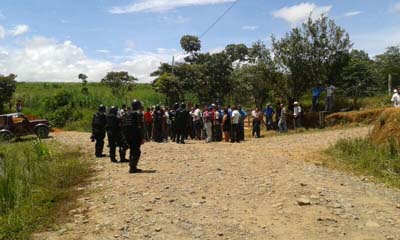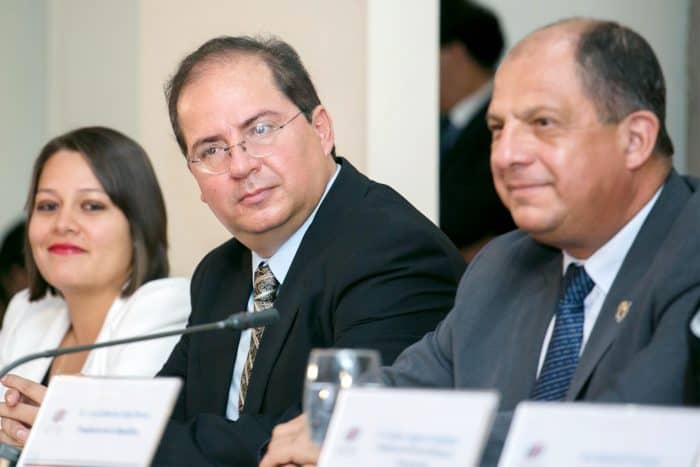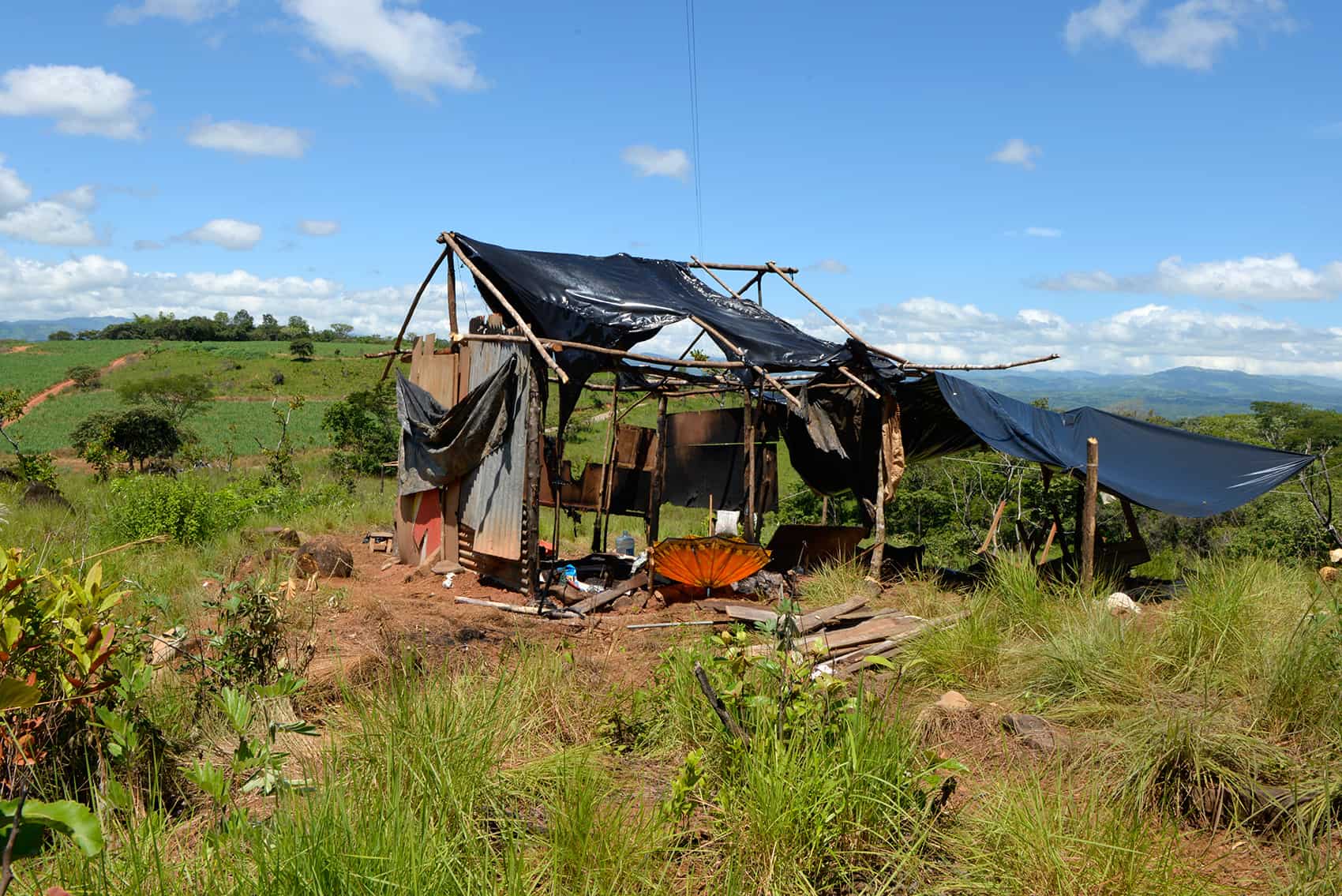An indigenous rights issue has put Costa Rica’s much-vaunted human rights record to the test as the country struggles to protect members of the Bribrí and Teribe indigenous communities from non-indigenous people who have forcibly, and at times violently, removed them from indigenous ancestral lands.
In late September a group of Bribrí and Teribe leaders complained that the government failed to consult them before putting into place “precautionary measures” ordered last April by the Inter-American Commission on Human Rights. The measures included increased police presence in communities in and around the village of Salitre on the southern Pacific slope of the Talamanca Mountains, the scene of violence directed at the indigenous communities.
On at least one occasion early in the conflict that flared up in July 2012, police officers participated in the forced removal of indigenous people from their land, and indigenous residents complain the police have stood by and done nothing to stop the attacks, according to indigenous groups.
The tripling of the police presence to some 60 officers came after several years in which the Bribrí have been subject to attacks by machete- and club-wielding “whites” trying to chase the indigenous off their land by burning their houses and crops. On Sept. 17, 2012, Bribrí leader Sergio Rojas, 57, the controversial president of the Salitre Integral Indigenous Development Association, was shot at six times while riding in a taxi in an apparent assassination attempt near the reserve.
Non-indigenous attackers allege that the estimated 1,800 indigenous people are squatters, even though the land lies inside the confines of an indigenous reserve established in 1977.
The problem, said Minor Mora, a member of the municipal council of Buenos Aires, a lowland regional hub, has its roots in the 1977 Indigenous Law that gave the Bribrí and the Teribe rights to 11,700 hectares of land but did not provide for funds to compensate farmers who already occupied the land. In the interim the population has grown to more than 3,200 non-indigenous people, including those who have been on the land for decades and those who are more recent arrivals and bought the land with nothing more than an illegal bill of sale.
Mora said removing those families from the reserve without compensating them would create its own set of social and humanitarian problems.

‘It’s hard to come to a solution’
Government spokesman Mauricio Herrera said the indigenous community is divided in many different factions, complicating a negotiated solution. The government did consult one of the factions, he said, but one faction is stubbornly demanding a quick solution of removing the non-indigenous from the land.
“It is hard to come to a solution, when one of the sides is intransigent,” Herrera said.
The Bribrí faction that complained about not being consulted has refused to negotiate anything besides their own proposed solution: the removal of all non-indigenous inhabitants from the land to which they hold an ancient claim.
But the situation is more complex than merely an indigenous versus non-indigenous conflict, Herrera said.
“You have situations where Bribrís are married to ‘white’ people,” Herrera said. “And you have other situations where a Bribrí is married to a Cabécar,” referring to the indigenous group closely related to the Bribrí.
Mora also said certain interests he did not name were concerned about cashing in on a government program that compensates landowners for not cutting down forest as part of Costa Rica’s carbon-neutral effort.
The Salitre Integral Indigenous Development Association manages the money, and Rojas, as its president, was jailed for seven months in preventive detention beginning in November 2014 while the investigation into alleged malfeasance of ₡554 million ($1 million) going to the carbon-neutral fund was investigated.
Rojas has also been the target of charges that he has used his position to intimidate other members of the indigenous community who didn’t accept his leadership and used his power to decide who qualifies as “indigenous” and who doesn’t, leaving out Bribrís who rightly have a claim to living in the reserve.
Rojas denied the accusation. “It’s false. Nobody can decide who is and who isn’t Bribrí. You are Bribrí if you follow our traditions and our customs. There was no intimidation,” he said.
Amilcar Castañeda, an anthropologist at Costa Rica’s State University at a Distance, said the charges and detention of Rojas were politically motivated because of Rojas’ role in the Salitre land dispute. Rojas also said it was politically motivated, claiming that he was held without being charged with a crime.
“He was a political prisoner,” said Castañeda. “It’s a case where there was disorder in the management of the association’s funds. It’s something that’s very common everywhere in the country and no one else has ever been accused of anything.”
University of Costa Rica anthropologist Marcos Guevara agrees. “The non-indigenous people do not want a strong leader who has a purpose of recovering land,” said Guevara. “Rojas poses a special danger because he can inspire indigenous in other parts of the country to demand their rights for the land.”
Neither Castañeda nor Guevara has seen the documentation allegedly supporting the accusations.
“In two years and eight months since the process began in which the 11 directors of the Integral Indigenous Development Association have been investigated, they haven’t been able to demonstrate that the supposed charges they are accused of occurred, nor any connection with them,” Rojas’ attorney Ruben Chacón told the press.
Meanwhile, alleging irregularities, the government’s National Community Development Directory (DINEDECO) removed Rojas from his position as president of the Salitre Integral Indigenous Development Association during an Aug. 23 association assembly to elect the indigenous leader, according to the weekly Semanario Universidad.
DINEDECO has declared the assembly illegal because some who asked to be included were prohibited from joining while others who had no right to participate were allowed. The space where the assembly was held also was not big enough to allow for full participation.
DINEDECO said Rojas was prohibited from holding public office until Oct. 5.
Determining who has to stay and who has to go
As part of the precautionary measures, the government has proposed carrying out a study to sort out the situation to determine exactly who has to stay and who has to go, as well as who will be compensated and who will not.
But Rojas said the Bribrí welcome mixed families into the community and that the government proposal is nothing more than a dilatory move.
“What we want is for them to apply the legislation that protects our rights,” he said.
The IACHR intervened after receiving a petition from the nonprofit Forest People Programme to protect members of the Bribrí and Teribe communities. The members of the indigenous community, according to the IACHR, “find themselves in a grave and urgent situation since their lives and personal integrity are threatened and are at risk.”
According to the IACHR, the government gave the indigenous people title to the land in 1956, and then in 1977, gave them rights to the land in perpetuity under the Indigenous Law that created an extensive system of 24 indigenous reserves in the country – mostly in the rugged, remote Talamanca mountains that sprawl across the Panama border in the south of the country.
But over the years settlers already on the land when the Indigenous Law passed, combined with squatters, have claims to about 60 percent of the land nationwide, sometimes with no more claim than an illegal bill of sale, said Castañeda.
In Salitre, Herrera said that some of the non-indigenous landowners who have been there for decades would have to be compensated if removed, while more recent arrivals would not.
But Castañeda said that most of the land being reclaimed by the Bribrí and Teribe has been taken over by absentee “owners” who live in the regional lowland hub of Buenos Aires, and it is physically occupied by no more than caretakers.

In issuing its ruling calling for precautionary measures, the IACHR said that the gravity of the situation exists in view of “a series of continuous cycles of threats, harassment and acts of violence against members of the Teribe and Bribrí communities of Salitre.”
According to the IACHR, in the Salitre area about 60 percent of the Bribrí land has been taken over by outsiders, and between 80 and 88 percent of land belonging to the Teribe.
The non-indigenous “owners” of the land consider the indigenous to be the invaders. In August 2012, the Buenos Aires municipal council declared Rojas persona non grata.
The indigenous communities’ latest effort to reclaim their land dates to July 2012, when Rojas organized a group of indigenous people to return. The families had been living either in slums in Buenos Aires or numerous families to a house inside the reserve, Rojas said.
“There was no reason for our people to live like that when we had a right to our own land, so we organized an effort to take it back,” Rojas said.
The Forest Peoples Programme alleged that despite numerous meetings between the indigenous leaders, the non-indigenous owners and the government, the latter did not take adequate measures to protect the indigenous communities.
Costa Rica’s indigenous peoples, estimated at around 60,000, remain the poorest and most marginalized sector of Costa Rican society.
Living in remote areas of the country, often far from vital services, indigenous communities consistently rank at the bottom of the country’s human development indices. Indigenous groups like the Teribe have seen their culture decimated and have little left of their language.
The Bribrí and the closely related Cabécar groups have been able to retain more of their culture and language, thanks in large part to the remoteness of their villages in the rugged, virtually inaccessible zones of the Talamanca mountains.
Correction: A previous version of this story incorrectly converted ₡554 million to $110 million. It’s actually $1 million. We regret the error.






